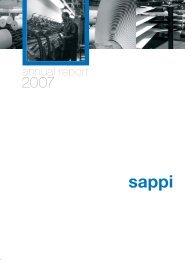2012 Integrated report - Sappi
2012 Integrated report - Sappi
2012 Integrated report - Sappi
Create successful ePaper yourself
Turn your PDF publications into a flip-book with our unique Google optimized e-Paper software.
Governance and compensation continued<br />
Summary of how <strong>Sappi</strong> applies the principles contained in King III continued<br />
Principle<br />
Chapter 5 – IT governance<br />
IT governance 5.1. The board should be<br />
responsible for information<br />
technology (IT) governance<br />
5.2. IT should be aligned with the<br />
performance and sustainability<br />
objectives of the company<br />
5.3. The board should delegate to<br />
management the responsibility<br />
for the implementation of an IT<br />
governance framework<br />
5.4. The board should monitor and<br />
evaluate significant IT<br />
investments and expenditure<br />
5.5. IT should form an integral part<br />
of the company’s risk<br />
management<br />
5.6. The board should ensure that<br />
information assets are<br />
managed effectively<br />
5.7. A risk committee and audit<br />
committee should assist the<br />
board in carrying out its IT<br />
responsibilities<br />
Chapter 6 – Compliance with laws, rules, codes and standards<br />
Compliance 6.1. The board should ensure that<br />
the company complies with<br />
applicable laws and considers<br />
adherence to non-binding<br />
rules, codes and standards<br />
6.2. The board and each individual<br />
director should have a working<br />
understanding of the effect of<br />
the applicable laws, rules,<br />
codes and standards on the<br />
company and its business<br />
6.3. Compliance risk should form<br />
an integral part of the<br />
company’s risk<br />
management process<br />
6.4. The board should delegate<br />
to management the<br />
implementation of an effective<br />
compliance framework and<br />
processes<br />
Summary of how <strong>Sappi</strong> applies the King III principles<br />
The board is responsible for IT governance. The CIO provides regular feedback to<br />
the audit committee and board on IT governance matters. An IT steering<br />
committee exists and policies are established and implemented. <strong>Sappi</strong> promotes<br />
an ethical IT governance culture and a common IT language<br />
IT is aligned with the performance and sustainability objectives of the company<br />
from a strategic and business process perspective. There are also processes to<br />
identify and exploit opportunities to improve performance and sustainability<br />
through the use of IT<br />
The board has delegated responsibility for the implementation of an IT governance<br />
framework to management. All IT matters of a global nature are referred to a<br />
group IT council (GITCO) which makes decisions on the most appropriate<br />
technological solutions for the group. Decisions are ratified by an executive group<br />
IT steering committee<br />
All IT projects are presented to cross functional teams within the regions for<br />
sign-off. Post implementation audits are conducted on large IT projects. The CIO,<br />
on behalf of the Group IT steering committee presents to the audit committee and<br />
board regarding the value delivered by IT investment<br />
IT is represented on the group and regional risk management teams and ensures<br />
that IT risk management is aligned with the company’s risk management process.<br />
IT risk assessment updates are undertaken every six months using the group’s risk<br />
management software. Feedback on IT risks, business continuity and disaster<br />
recovery is provided by the CIO to the audit committee and the board. IT have<br />
processes to identify and comply with relevant IT laws and standards<br />
IT systems and processes have been developed for managing information assets<br />
effectively, including personal information. This includes information security,<br />
information management and privacy. The information security strategy has been<br />
approved by the board and delegated to management for implementation<br />
The audit committee which assists the board in risk management has oversight of<br />
IT risks, IT controls and related combined assurance. This includes financial<br />
<strong>report</strong>ing matters. Technology is used to improve audit coverage and efficiency<br />
<strong>Sappi</strong> has a compliance culture with a legal compliance programme which<br />
supports efforts to identify and comply with applicable laws and regulations.<br />
Compliance also forms part of <strong>Sappi</strong>’s code of ethics. The board is briefed on<br />
new regulations and <strong>report</strong>s from the legal compliance programme are provided<br />
regularly to the audit committee and board<br />
The board and individual directors are made aware of new regulations or changes<br />
that affect the company<br />
A compliance function has been established and the risk of non-compliance forms<br />
part of the risk management process<br />
<strong>Sappi</strong> has an established legal compliance programme including policies and<br />
procedures to educate, train, measure and communicate compliance matters.<br />
Material aspects of non-compliance would be disclosed in the integrated <strong>report</strong> if<br />
applicable. A sufficiently independent and skilled compliance officer has been<br />
appointed. Legal compliance works closely with ethics and risk management and<br />
the head of the legal function is a member of the executive committee and attends<br />
board and audit committee meetings<br />
78
















